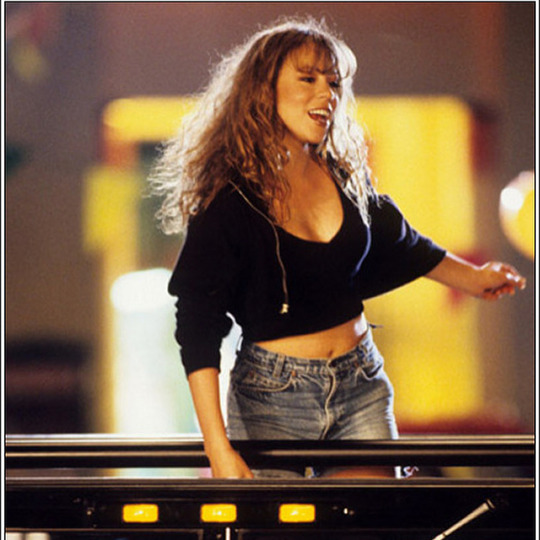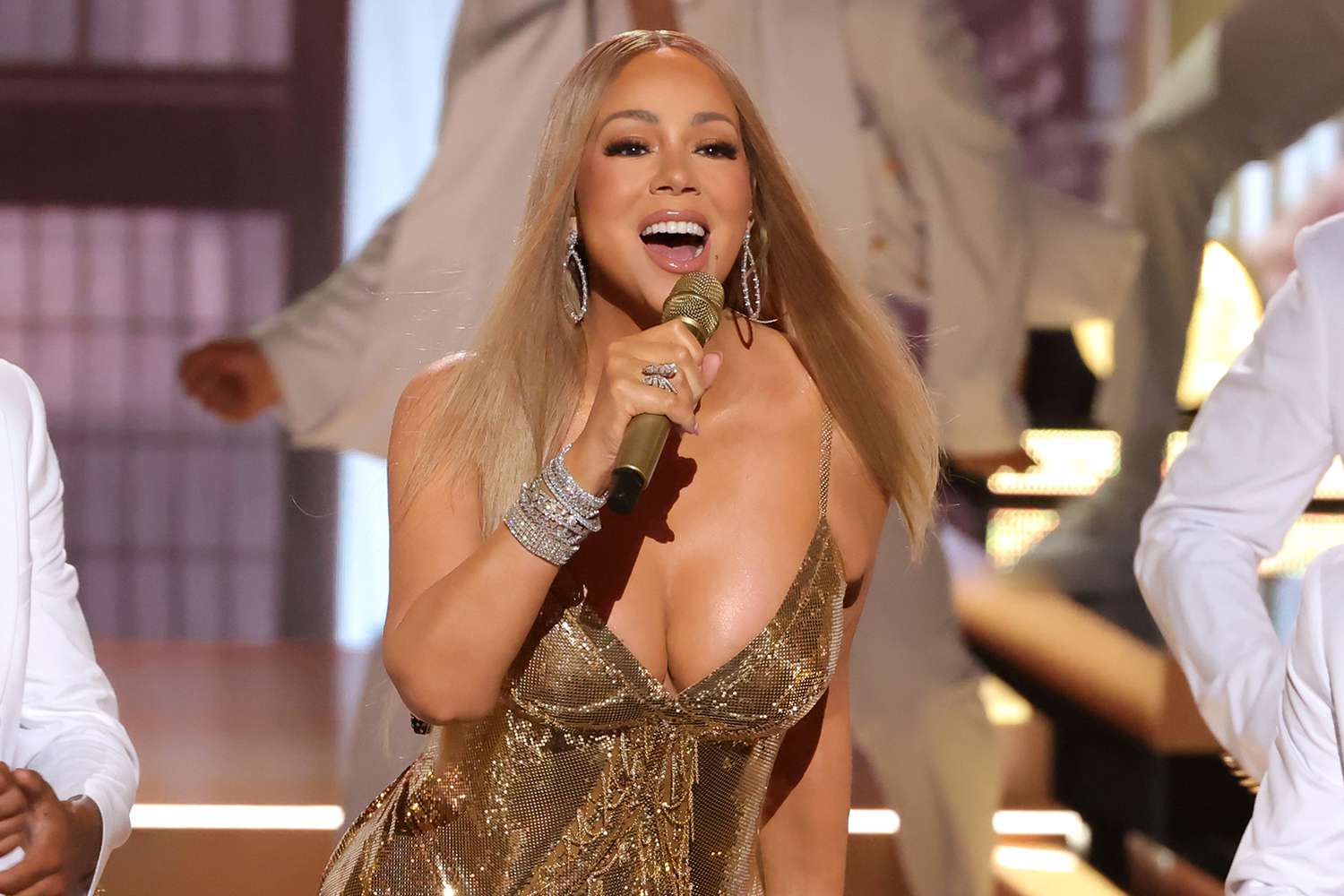- News

Unveiling the Truth: Mariah Carey’s ‘Glitter’ – Was It Really a Flop?
Dive into the debate surrounding Mariah Carey’s ‘Glitter’ – was it a sales flop or a misunderstood gem? Unravel the cinematic and musical journey with us!

Glitter, etched in the annals of cinematic history as one of the industry’s biggest missteps, invites a nuanced examination of whether it truly earned its reputation as a colossal flop. Positioned against the backdrop of a post-9/11 world, the film’s financial underperformance, often attributed to its modest box office returns compared to its $22 million budget, reflects a complex interplay of circumstances. The juxtaposition of Mariah Carey’s glamorous billboards against a mourning New York City further compounded its struggles. Was the movie as much of a flop as advertised, or did it succumb to a perfect storm of unfortunate timing and global sentiment shift?
In stark contrast to the film, Glitter‘s soundtrack emerged as a phoenix from the cinematic ashes. Mariah Carey’s musical prowess shone through, with tracks like “Loverboy” and “Never Too Far” establishing a presence on music charts. The soundtrack’s success, seemingly divorced from the film’s shortcomings, raises the question: Was the soundtrack as much of a flop as advertised, or did it defy expectations, offering a musical redemption that overshadowed the film’s narrative stumble? Thus, the narrative surrounding the film’s failure is a tale of two dimensions — a cinematic stumble marred by external circumstances and a musical underrated gem that underscores Mariah Carey’s enduring influence in the realm of music. Let’s take a deeper look at whether Glitter truly stands as the monumental flop it’s often portrayed to be.
Behind the Scenes: Mariah Carey’s Journey in Bringing ‘Glitter’ to the Big Screen
To understand the challenges surrounding the release of Glitter (originally titled All That Glitters) and its subsequent reputation restoration efforts, we must rewind to the years before the turn of the millennium when Mariah Carey sought opportunities in the film industry. Facing skepticism about her transition from the music world, Carey signed on for various film projects, including a James Bond spoof called Double-O-Soul in 1998, which was set to feature the red-hot Chris Tucker but never advanced to the filming stages. Additionally, she made a cameo appearance as an opera singer in the 1999 romantic comedy The Bachelor. Amidst these endeavors, Carey conceived the concept for Glitter, a showbiz drama developed alongside screenwriter Kate Lanier.
Kate Lanier, the screenwriter for Glitter, was coming off the success of Gary Gray’s acclaimed all-female crime thriller Set It Off and the Tina Turner biopic What’s Love Got To Do With It. Her notable contributions to these films added an extra layer of anticipation to Glitter, creating expectations for a compelling narrative.
Mariah Carey’s cinematic endeavor embarked on a tumultuous journey that unfolded over several years. Commencing in 1997, Carey’s dual project, comprising a film and its accompanying soundtrack, faced unforeseen hurdles as Columbia Records, her label at the time, pressured her to release a compilation album for the holiday season in November 1998. Consequently, the ambitious All That Glitters project was temporarily shelved, only to resurface later as Carey’s creative focus oscillated between albums, including Butterfly in 1997 and Rainbow in 1999.
The narrative took a significant turn when Carey, amid a strained working relationship with Tommy Mottola, then head of Columbia Records and her ex-husband, sought to extricate herself from the label. In a pivotal move, Virgin Records stepped in, offering a staggering $20 million to release Carey from her contractual obligations, paving the way for a groundbreaking $100 million deal. With newfound creative control under Virgin Records, Carey aimed to realize her cinematic vision. However, as the release date neared, personal challenges emerged, including the end of her relationship with Latin singer Luis Miguel and the mounting pressure of her new record label, filming Glitter, and recording its soundtrack.
Following the initiation of Glitter and the release of the soundtrack’s lead single “Loverboy,” Mariah Carey embarked on a brief promotional campaign marked by what was perceived as “erratic behavior.” On July 17, 2001, during an interview on BET’s 106 & Park, Carey’s unconventional behavior raised eyebrows. Two days later, on July 19, she made an appearance on MTV’s TRL, pushing an ice cream cart and engaging in a seemingly impromptu striptease. These incidents were followed by a record signing event on July 20, where Carey continued to exhibit peculiar behavior. The culmination occurred on July 26 when she was hospitalized for “extreme exhaustion” and a “physical and emotional breakdown,” leading to an extended absence from the public eye.
In response to Carey’s publicized breakdown, Virgin Records and 20th Century Fox made an announcement on August 9, 2001, to delay the release of both Glitter and its soundtrack by three weeks. The postponement was attributed to Carey’s personal and physical condition, with Nancy Berry, vice chairman of Virgin Music Group Worldwide, expressing optimism about Carey’s recovery. Amidst the tumultuous events, Carey’s emotional vulnerability became evident, and her subsequent revelation of being diagnosed with Bipolar II disorder added a layer of complexity to her narrative. The challenges faced during the promotion and release of Glitter reflect not only the unpredictable nature of the entertainment industry but also the strength and resilience of an iconic artist navigating through personal and professional adversities.

Rhythmic Resilience: Mariah Carey’s Soundtrack Amid Personal Turmoil
Released in 2001 as both the soundtrack to the film and her eighth studio album, Glitter showcased a fusion of dance-pop, funk, hip hop, and R&B, diverging significantly from Carey’s previous works.
Collaborating with renowned names such as Jimmy Jam, Terry Lewis, and DJ Clue, Carey channeled the essence of the 1980s post-disco era to complement the film’s 1983 setting. The soundtrack became a canvas for a diverse array of musical acts, including Eric Benét, Ludacris, Da Brat, Busta Rhymes, Fabolous, and Ja Rule, contributing to a unique sonic tapestry.
In an interview with MTV News, Carey provided insights into her creative process, emphasizing the soundtrack’s ability to transport listeners back to the ’80s while maintaining the timeless quality of her signature ballads. The lead single, “Loverboy,” received a remix featuring a sample from Cameo’s “Candy,” infusing a nostalgic charm into the track. However, the production of this remix also marked a challenging period for Carey, as she grappled with the pressures of a changing industry landscape and her own evolving sound.
The soundtrack further unfolded with emotionally charged ballads such as “Lead the Way” and “All My Life,” showcasing Carey’s vocal prowess and emotional depth. Amidst creative differences with long-time collaborator Walter Afanasieff, Carey halted work with him after completing “Lead the Way,” marking a poignant moment in her artistic journey.
Despite the personal turmoil, Carey’s musical resilience shone through in tracks like “Didn’t Mean to Turn You On,” a cover of Cherelle’s 1984 song, and “Never Too Far,” a soulful slow-jam love song. The album’s closing track, “Twister,” dealt with the quietly heartbreaking subject of the suicide of Carey’s friend and hairstylist, Tonjua Twist, adding a layer of emotional complexity to the project.
Inside Mariah Carey’s Musical Odyssey: ‘Loverboy’ and Industry Intricacies
In 2000, Mariah Carey was in the process of creating material for the Glitter album when she conceptualized “Loverboy.” Originally, Carey sampled the melody from Yellow Magic Orchestra’s 1978 song “Firecracker,” using it throughout the chorus and introduction. The original version of “Loverboy” with this sample was featured in early theatrical trailers for Glitter. However, as Carey ended her contract with Columbia Records, her ex-husband Tommy Mottola signed Jennifer Lopez, who began recording for her album J.Lo (2001). Mottola, aware of Carey’s use of the “Firecracker” sample, allegedly attempted to have Lopez use the same sample before Carey, leading to tensions and paranoia on Carey’s part.
Despite Carey having initially licensed the “Firecracker” sample, logistical challenges emerged. Lopez’s album was set to release earlier than Glitter, preventing Carey from using the original sample. Consequently, Carey altered the composition of “Loverboy,” replacing the “Firecracker” sample with “Candy” by Cameo. The “Firecracker” sample was eventually utilized by Lopez in her song “I’m Real.” Irv Gotti, a record producer, claimed Mottola instructed him to create the Murder Remix of “I’m Real” to sound like another Glitter track, “If We,” featuring rappers Ja Rule and Nate Dogg. The original version of “Loverboy” with the “Firecracker” sample was later released on Carey’s 2020 compilation album The Rarities. This complex saga highlights the intricate challenges and industry dynamics surrounding the creation of “Loverboy” and the Glitter album. But it wasn’t over yet…
The September 11 Dilemma: Mariah Carey’s ‘Glitter’ and Its Doomed Premiere
September 11, 2001, is etched in history as one of the darkest days in America, forever altering the course of the nation. Against this grim backdrop, Mariah Carey’s film Glitter faced an ill-fated release date, inadvertently entwining its narrative with the tragic events of that fateful day. The majority of the film unfolds in New York, featuring poignant scenes with the World Trade Center standing tall in multiple frames, a stark reminder of the city’s irrevocable connection to the disaster.
Compounding the challenge, a substantial portion of Glitter’s marketing budget was strategically executed in New York. In a city grappling with the aftermath of one of its worst disasters, billboards featuring Mariah Carey, adorned in glitter, starkly contrasted with the somber mood that permeated the streets.
September 11, 2001, undoubtedly presented an unfavorable climate for any release, and Mariah Carey’s Glitter was not the sole contender. Albums from artists like Jay-Z, Nickelback, Bob Dylan, Fabulous, and P.O.D. also debuted on that ominous day, but each managed to fare better than Glitter. Despite being one of the best-selling artists in music history, Carey’s cinematic endeavor fell short, selling only a fraction of her previous work.
Undeterred by the challenges and her well-documented struggles, Mariah Carey exhibited resilience. On September 20, she made her first public appearance at a Glitter screening, donning a black shirt adorned with a sparkly American flag—a subtle yet powerful symbol of unity and strength. The following day, Glitter premiered in approximately 1,200 theaters, coinciding with Carey’s heartfelt performance of “Hero” at the George Clooney-organized TV benefit, America: A Tribute to Heroes.
The film, however, officially hit theaters on September 21, 2001, a mere ten days after the release of the accompanying soundtrack on September 11, 2001. Mariah Carey’s determination to navigate the challenging release environment, coupled with her poignant public appearances, marks a chapter in her career that intertwines with a pivotal moment in American history, forever shaping the narrative of Glitter.
Mariah Carey’s Cinematic Catastrophe: Unpacking the Scathing Reviews of ‘Glitter
As previously mentioned, Mariah Carey’s 2001 film and soundtrack, Glitter, faced numerous issues that contributed to its failure. The release coincided with Carey’s personal struggles, including the end of her marriage to Sony Music Entertainment chief Tommy Mottola and a breakup with singer Luis Miguel. The film mirrored details from Carey’s life, leading to skepticism and accusations of navel-gazing – “This star vehicle for singer Mariah Carey is primarily a showcase for her breasts,” the Washington Post’s Megan Rosenfeld wrote. “And if they gave out Oscars for body parts, this pair would be contenders.”. Carey also had creative differences with director Leonard Hornick and cinematographer Geoffrey Simpson, leading her to believe that they were shooting her on her bad side on purpose.
The film received overwhelmingly negative reviews, with critics panning Carey’s performance and the movie’s use of cliches. It was so heavily panned by critics and audiences that it earned Carey a Razzie for worst actress. A New York Times critic said audience members “erupted repeatedly into laughter at scenes intended to carry emotional weight.” The film was considered one of the worst films ever made, and Carey herself has distanced herself from it, refusing to perform any songs from the soundtrack in her concerts for over two decades. The film’s failure wreaked havoc on Carey’s career, causing a “horrible couple of years” before she could regain momentum. Da Brat, who appeared in the film, also claimed that it was a “major commercial failure and critical flop.” The album accompanying the film received mixed reviews, with some critics praising Carey’s songwriting and voice but criticizing the abundance of guest rappers. Overall, Glitter remained a major regret for Carey, who called it a “kitsch moment in history” in a 2013 interview.

Analyzing Glitter’s Commercial Letdown: Box Office and Soundtrack Sales
Glitter faced a challenging box office debut in the United States on September 21, 2001. Despite grossing $786,436 on the opening day and ranking eleventh for the weekend with $2,414,596, the film witnessed a steep 61.1% drop in ticket sales by the second week. Ultimately, Glitter proved to be a commercial failure, earning only $4,274,407 domestically against a $22 million budget. Mariah Carey acknowledged the unfavorable timing, stating, “I don’t even know that many people even saw the movie.”
Despite the commercial challenges and contractual turmoil surrounding Glitter’s soundtrack, the album managed to achieve significant success internationally. It secured top positions on charts across various countries, including Australia, Austria, Belgium, Canada, France, Germany, Greece, Italy, Japan, Malaysia, New Zealand, Spain, Switzerland, and the UK. In the United States, it reached number 7 on the Billboard 200 and claimed the top spot on the US Soundtrack Albums chart.
Nevertheless, Glitter’s soundtrack faced a rocky journey in the United States, marked by poor sales and contractual disputes. Following disappointing album sales, Virgin invoked a contractual clause, allowing the label to exit the $100 million deal for approximately $28 million. This decision was influenced by negative publicity surrounding Mariah Carey’s breakdown. The contractual dispute led to Carey’s departure from Virgin, and despite threats of legal action and counter-suits, the matter was eventually resolved outside of court. Carey subsequently signed a new $20 million deal with Island Records, marking a fresh chapter in her career.
It’s worth noting that, despite the challenges, Glitter’s soundtrack has been certified in various countries, totaling 2 million units sold. This includes the prestigious RIAA platinum status, underscoring the enduring appeal and recognition the album received despite its turbulent journey.
In addition to the international sales of Glitter’s soundtrack, one of its standout tracks, “Loverboy,” achieved notable recognition on the charts. The song reached an impressive peak at number 2 on the charts, contributing to the soundtrack’s overall acclaim. However, it’s crucial to acknowledge that critics pointed out the impact of heavily discounted single sales at 49 cents on “Loverboy’s” chart performance.
Despite the controversies surrounding its chart position, “Loverboy” managed to emerge as the biggest-selling single of the year in the United States. The unique combination of catchy melodies and discounted sales played a significant role in the song’s commercial success. This achievement further demonstrates the complex dynamics surrounding Glitter’s soundtrack, where commercial challenges and unconventional strategies intersected to create moments of both criticism and triumph within the music industry.
How Social Media Saved Glitter: The Rise and Impact of #JusticeForGlitter
The resurgence of #JusticeforGlitter in 2018 signaled a shift in the public perception of Mariah Carey’s infamous film and album, “Glitter.” Initially dismissed as a cinematic and musical disaster, the hashtag movement aimed to reevaluate the work within the context of changing cultural attitudes. While critics still point out flaws like flat dialogue and uninspired pacing, there’s a growing acknowledgment of the film’s themes promoting self-resilience and determination.
Carey’s response to the campaign marked a significant departure from her previous stance, adopting a more positive outlook. She acknowledged the success of the album, even declaring it “really good” after it reached number one on the charts. The movement also brought attention to the unfair criticism Carey faced during the film’s release, shifting the narrative from mockery to empathy for the challenges she endured.
The post-2018 reappraisal of “Glitter” not only prompted retrospective reviews but also elevated the film to cult status. Critics and fans began recognizing its unique qualities, with some describing it as a symbol of Carey’s tenacity and innovation throughout her career. The campaign’s impact extended beyond social media, as the soundtrack album soared on various charts and even earned a spot on Carey’s subsequent concert tour.
Ultimately, #JusticeforGlitter became more than just a campaign to rehabilitate the film’s reputation; it became a testament to the changing dynamics of celebrity culture and the power of fan-driven movements in reshaping public opinion. The once-maligned “Glitter” found redemption through a newfound appreciation for its cultural significance and the resilience of its creator.
In conclusion, the #JusticeForGlitter movement has undeniably played a pivotal role in reshaping the narrative surrounding Mariah Carey’s infamous project. What was once labeled a commercial disaster and critical failure has experienced a remarkable resurgence, thanks to the unwavering support of Carey’s devoted fanbase. The hashtag not only brought Glitter back to life but propelled it to the top of iTunes charts in numerous countries, a feat that seemed unimaginable in the aftermath of its 2001 release.
The album’s performance on streaming platforms further solidifies its newfound success, with a staggering 22 million streams on Spotify alone since its 2020 release on the platform. These numbers challenge the notion of Glitter being a true flop, especially considering its late-blooming popularity. While the soundtrack may have fallen short of Carey’s previous astronomical standards, surpassing 2 million sales worldwide is a testament to its enduring appeal. And while hardcore lambs await the rumoured re-release of the pink Glitter vinyl, the equivalent album sales aren’t set to stop here.
In retrospect, the Glitter era was a challenging chapter for Mariah Carey, marked by personal trials, critical scorn, and a challenging industry landscape. However, the #JusticeForGlitter movement has not only salvaged the film and soundtrack from the shadows of obscurity but has also sparked a reevaluation of their cultural significance. Glitter may not fit the conventional definition of a blockbuster, but its resilience and enduring fan support have cemented its place in the legacy of a pop music icon. The notion of success is relative, and in the case of Glitter, its post-2001 journey proves that sometimes, even perceived flops can shine bright when given a second chance.






2 thoughts on “Unveiling the Truth: Mariah Carey’s ‘Glitter’ – Was It Really a Flop?”
Thanks for sharing. I read many of your blog posts, cool, your blog is very good.
Your article helped me a lot, is there any more related content? Thanks!